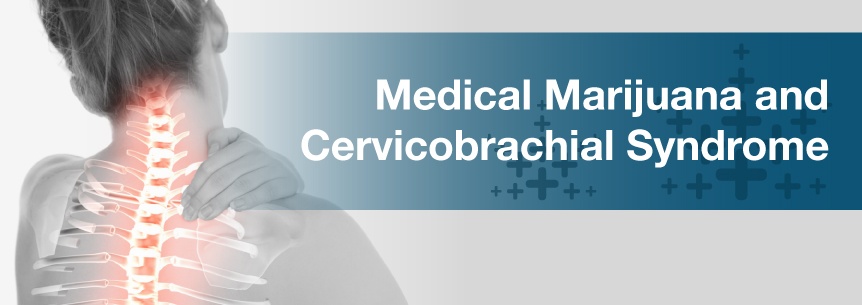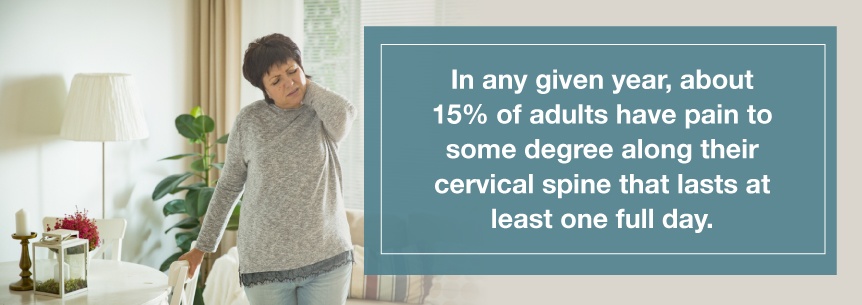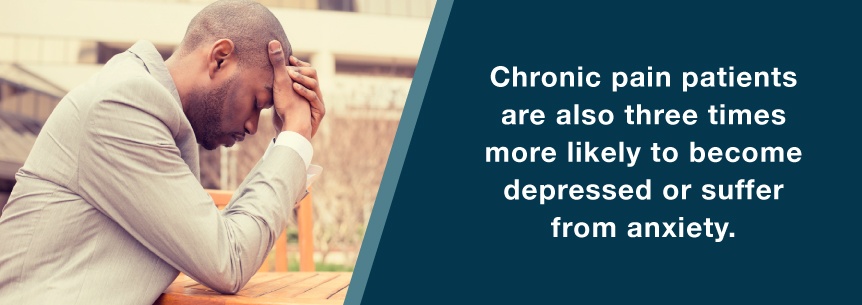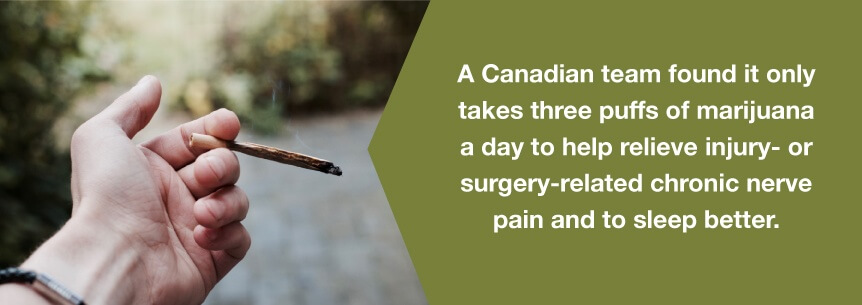
If you’re struggling with the pain and inflammation caused by cervicobrachial syndrome, no doubt you’ve tried almost anything you can get your hands on to find some relief. The condition can bring on extreme pain and can affect your quality of life. Medical marijuana for cervicobrachial syndrome may be the answer you’re looking for.
Cervicobrachial syndrome, also called cervicobrachalgia, is a condition causing stiffness and pain of your cervical spine extending to your upper extremities and shoulder girdle — the shoulder blade and collarbone. It manifests with degenerative changes, which include:

In any given year, about 15% of adults have pain to some degree along their cervical spine that lasts at least one full day. Estimates show cervicobrachialgia is more prevalent in isolation than neck pain and is common among individuals looking for physiotherapy treatments for arm and neck pain. One study found a 32 percent recurrence in individuals with cervicobrachial discomfort and pain over a nearly five-year period.
Many cervicobrachial syndrome patients perform manual work with repetitive and continuous tasks such as:
People with the condition may find performing tasks where they need to hold the same neck position for long periods exasperating.
Cervical radiculopathy, which involves damage to nerve function, is the primary reason for cervicobrachial syndrome. It causes lesions affecting the vertebrae’s c5/6 and c6/7 motion sections. Intervertebral joint and degenerative disc changes usually lead to the pain.
The condition may also occur because of thoracic outlet vascular and neurogenic compression. With cervicobrachial syndrome, your vertebrate nerve endings can be compressed and irritated. The muscles affected are mostly found in the trunk’s upper portion since cervical nerve roots supply this area primarily.
Common causes of cervicobrachialgia are:
Repeated muscular strains or sudden movements may provoke cervical pains. Frequently, irritation of the ligaments and joints cause these pains. Because the autonomic nerve fibers and vertebral artery are extremely close to the joints, this adds on a neurovascular component, which means both your blood vessels and nerves are involved.
Cervicobrachial syndrome symptoms affect the upper portion of your trunk, which includes your:
Common symptoms of the condition may include:
While no clinical diagnostic criteria for cervicobrachial syndrome is agreed on, findings often include fatigue and pain of the:
You may experience numbness or heaviness of your upper extremities and a swelling sensation in your hands. Activity almost always increases the pain, and rest relieves it. However, during the night, the pain can get worse and cause problems with sleep.
Some people say they feel as though they’re wearing gloves when they’re not. Painful headaches, sometimes in the form of a migraine, also can accompany the other symptoms of cervicobrachial syndrome.
The chronic pain you experience with cervicobrachial syndrome isn’t only something you suffer with physically. You can also struggle with it emotionally, and it can influence your mood and thoughts. Chronic pain sufferers often can’t achieve mobility they used to have and might isolate themselves from other people.

Chronic pain patients are also three times more likely to become depressed or suffer from anxiety. Depressed individuals may struggle to maintain or improve physical health. Their pain can result in increased stress, trouble sleeping or feelings of worthlessness or guilt associated with depression. All these influences combined can turn into a vicious cycle.
The National Institutes of Health (NIH) published a study to help determine how often cervicobrachial pain becomes neurogenic, meaning it’s controlled or caused by the nervous system. Out of 361 participants of the study, 206 were males and 155 were females. The study showed the neurogenic cervicobrachial pain frequency to be 19.9 percent and the non-neurogenic symptom sources attributed to 80.1 percent of participants.
Your doctor will use your description of your symptoms, your medical history and a physical exam to make a cervicobrachial syndrome diagnosis. They might order a CT scan or MRI to confirm nerve root compression at the spinal cord level. Cervicobrachial syndrome calls for a highly individualized treatment plan only your healthcare professionals can provide.
The goal of treatment is to eliminate the pain, inflammation and other symptoms while maintaining mobility and flexibility. Hopefully, this will help prevent long-term disabilities from occurring. Overall, though, a significant point of treatment is to improve and maintain your quality of life. Some treatment options are:
Numerous treatment options exist depending on the severity of your condition. Conservative treatment for less severe cases of cervicobrachial syndrome include:
A hot water bottle or warm bath can relax muscle contractions and reduce symptoms.
Commonly, physicians suggest or prescribe certain pain and anti-inflammatory medications to reduce pain and inflammation associated with cervicobrachial syndrome.
Side effects of anti-inflammatory and pain medication may include:
In the acute phase, your doctor might prescribe you cortisone medications. Side effects of cortisone include insomnia, acne, mood changes, dizziness, headache and more. When your pain decreases, your doctor may administer a non-steroidal anti-inflammatory medication, like Voltaren (diclofenac) or a muscle relaxant, like Muscoril that don’t have the side effects that can happen with cortisone.
McKenzie exercises is a potential treatment pushing your nucleus pulposus back to its natural position, reducing spine root compression and pain. While your intervertebral disc won’t be the same as it was before, your doctor might be able to alleviate your symptoms with physiotherapy. You’ll need to perform exercises that strengthen your spinal muscles since the muscle weakness and ligament laxity in cervicobrachial neuralgia causes your spine to become unstable.
This is a manual treatment for relaxing the tension and releasing locked joints and nerve compression. It involves manipulation and massage of the joints, bones and muscles.
In more severe cases, if your cervicobrachial syndrome condition doesn’t heal after several months, you may require surgery. There are three distinct surgery techniques:
A Canadian team found it only takes three puffs of marijuana a day to help relieve injury- or surgery-related chronic nerve pain and to sleep better. This suggests medical marijuana for cervicobrachial syndrome could help with these symptoms associated with the condition. Further, around 10 to 15 percent of chronic pain clinic patients use medical weed as part of their overall pain management strategy, says assistant professor of anesthesia and family medicine at McGill University in Montreal Mark Ware, MD.

Cannabinoids are powerful anti-inflammatories and exert their effects through inhibition of cell proliferation, induction of apoptosis, induction of T-regulatory cells (Tregs) and suppression of cytokine production.
Marijuana and cervicobrachial syndrome treatment can be effective at curtailing the pain and reducing chronic inflammation of not just this condition, but other inflammatory-related diseases as well due to its cannabinoids like THC. The cannabinoids in medical marijuana act on the CB1 and CB2 receptors involved in the mediation of pain linked to inflammation.
Cannabis and cervicobrachial syndrome treatment can help treat the condition’s symptoms such as:
Let’s explore several of these symptoms and how cannabis helps:
Some individuals with chronic pain use cannabidiol (CBD) oil. CBD oil can assist in relieving inflammation, pain and overall discomfort related to numerous health ailments. CBD oil is a cannabis product. CBD is a cannabinoid naturally found in hemp and marijuana plants. It doesn’t produce a “high” sensation typically associated with marijuana caused by the THC cannabinoid.
Studies on CBD oil being effective at managing pain are showing much promise. It provides people with an alternative treatment to control their pain instead of having to rely on addictive medications like opioids.
Medical cannabis for cervicobrachial syndrome has sedating effects. Cannabis can make it easier for individuals to:
THC isn’t the only cannabinoid to help with sleep. All cannabinoids are potent sleep aids in general. Potent CBD-rich tinctures and oils taken a few hours before going to bed facilitate restful sleep with their balancing effects.
Edibles are a good consumption method for insomnia when you adhere to proper dosing. The effects of edibles kick in hours after taking them, so they can help you to stay asleep longer.
Medical weed is also known for its anti-inflammatory qualities. Researchers have now found it’s not just the plant’s psychoactive compounds responsible for these anti-inflammatory actions. There’s also a compound known as beta-caryophyllene, which we get each day from food, that helps reduce inflammation. Researchers are now finding beta-caryophyllene, which makes up around 12 to 35 percent of the essential oil in the cannabis plant, selectively activates the CB2 receptor.
Also, if you’re experiencing anxiety or depression because of cerviobroachial syndrome, medical cannabis could offer help.
When it comes to using cannabis for cervicobrachial syndrome, not all strains are the same. All the selected strains below help with pain management, inflammation, headache, insomnia, anxiety, depression and other cervicobrachial syndrome symptoms:
These strains are only a few suggestions. You have endless choices when it comes to selecting the best cannabis strain for your symptoms.
A great aspect of marijuana for cervicobrachial syndrome treatment is you also have many delivery methods. Some include:

To purchase cannabis for cervicobrachial syndrome legally, you’ll need to obtain a medical marijuana card. You can only receive this card from a qualified medical cannabis doctor who provides you with a recommendation.
To gain more knowledge about the herb and how it can help relieve your symptoms, book an appointment with a qualified marijuana doctor in your area. Our handy medical marijuana search tool enables you to search for a doctor in your specialty and distance from your zip code.
Then, your next step will be to browse our comprehensive directory of marijuana dispensaries, so you can begin your medical cannabis treatment and free yourself from the agonizing pain and other symptoms associated with cervicobrachial syndrome.
Find A Doctor Find A Dispensary